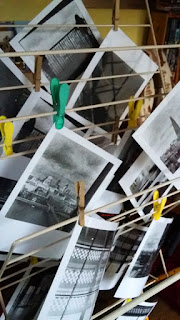It
is a great sense of achievement to behold a set of wet glistening
negatives in all their tonal glory. It is your first chance to see
how well they have been exposed and a relief to see all those
rectangles or squares in a row. But it is a time of controversy in
how you get them dry and clean.
Normal
wisdom states at the end of the processes you add half a dozen drops
of wetting agent to the last rinse, swish the reel about a few times
and leave to stand for a minute. This helps to break the tension of
the water so when you hang it to dry the water forms little droplets
that run off without leaving any water marks behind when it is dry.
The reality is quite different for some.
Wetting
agent is not some magic bullet that you cannot do without. Heresy! I
hear shouted from the back of the room! It is true the inter web is
filled with photographers bemoaning those calcium water marks unseen
until the print is hanging up to dry. You film scanners need not sit
there smugly because you can take it out using photoshop. I hear a
lot of complaints from this sector as well - time lost to spotting.
The real smug ones are those that never get this problem when they
use wetting agent. Well bully for you! Most of us do not have super
soft water that just caresses our film and falls off!
Please
do not get me started on those delicate lovelies that believe that if
you touch wet film it will be ruined. Lets have some reality here!
Wet film is a lot more resilient than it is given credit. For those
of a delicate disposition please look away as what I'm going to say
next is going to be outrageous to the extreme. I do not use wetting
agent and I use a damp shammy leather to wipe both sides of my film
dry.
It
is a shocking and stunning revelation, but I have had no choice in
the matter - honest officer! I have been plagued with wetting agent
contamination over recent times that no amount of cleaning and
washing has put right. This has led me to hand drying the film.
Before you start banging the door down I should point out that there
is a very nasty bit of kit called a film squeegee that has in the
past ruined countless frames of film by putting a scratch line
through them all. It took a long time and many rolls film to
discover. So I make no apologies for these outrageous actions.
Seriously!
I now have water mark free negatives that air dry more quickly and no
more blotchy looking prints. I wrote an article on how I discovered
that wetting agent was the problem. Called wetting agent
contamination.







